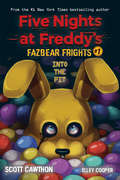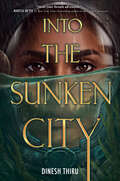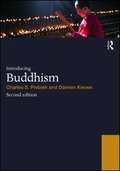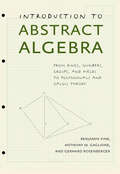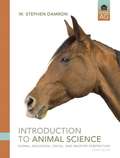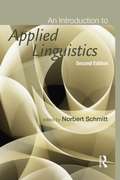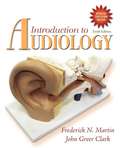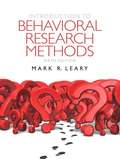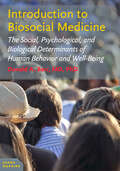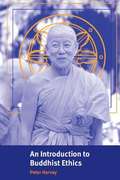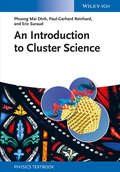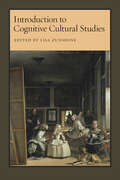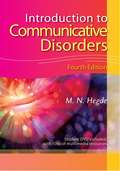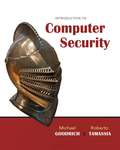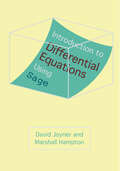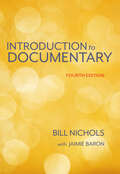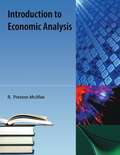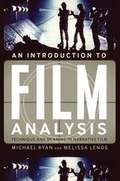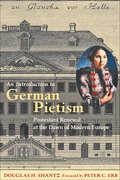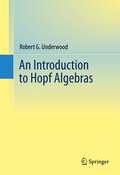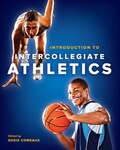- Table View
- List View
Into the Pit: An AFK Book (Five Nights At Freddy's #1)
by Scott Cawthon Elley CooperFive Nights at Freddy's fans won't want to miss this pulse-pounding collection of three novella-length tales that will keep even the bravest player up at night . . .What do you wish for most? It's a question that Oswald, Sarah, and Millie think they know the answer to. Oswald wishes his summer wasn't so boring, Sarah wishes to be beautiful, and Millie wishes she could just disappear from the face of the earth. But in the twisted world of Five Nights at Freddy's, their hearts' deepest desires have an unexpected cost.In this volume, Five Nights at Freddy's creator Scott Cawthon spins three sinister novella-length stories from different corners of his series' canon, featuring cover art from fan-favorite artist LadyFiszi. Readers beware: This collection of terrifying tales is enough to unsettle even the most hardened Five Nights at Freddy's fans.
Into the Sunken City
by Dinesh Thiru"Steal-your-breath adventure." —Marissa Meyer, #1 New York Times bestselling author of the Lunar ChroniclesPerfect for fans of Fable and House of Salt and Sorrows, this spectacular YA fantasy adventure debut is like nothing else, featuring a unique twist on Treasure Island, a magnetic second chance romance, and a thrilling heist where the reward is great—but the risks are even greater.In the slowly sinking city of Coconino, Arizona, the days are long, the money is tight, and the rain never stops.For Jin Haldar, this life is nothing new—ever since her father died in a diving accident, she’s barely made ends meet for her and her younger sister, Thara.Enter Bhili: a drifter who offers Jin and Thara the score of a lifetime—a massive stash of gold hidden in the sunken ruins of Las Vegas.Jin knows it’s too dangerous. She stopped diving after her father’s accident. But when her sister decides to go, Jin’s left with only one choice: to go with her.A ragtag crew is assembled—including Jin’s annoyingly hot ex-boyfriend. From there, a high-stakes heist ensues that’s beyond even Jin’s wildest fears. Crumbling ruins, sea beasts, corsairs, and a mysterious figure named João Silva all lie in wait. To survive, Jin will have to do what she promised herself she’d never do again: dive.
Introducing Buddhism
by Charles S. Prebish Damien KeownIntroducing Buddhismis the ideal resource for all students beginning the study of this fascinating religious tradition. It explains the religion's key teachings and traces its historical development and geographical spread of from its foundations up to present day. Charles S. Prebish and Damien Keown, two of today's leading Buddhist scholars, devote a chapter each to the major regions where Buddhism has flourished - India, South-east Asia, East Asia and Tibet. In addition, contemporary concerns are discussed, including important and relevant topics such as Engaged Buddhism, Buddhist Ethics, Buddhism and the Western World and Meditation. This new edition includes more material on the different schools of Buddhism including explanations in graphic form, monastic life, popular religion, Buddhist ethics, ritual, the Bodhisattva Path, the Jatakas, the transmission of Buddhism, and class, gender and race. Introducing Buddhismincludes illustrations, extracts from original sources, summary boxes, questions for discussion, suggestions for further reading and a companion website at www. routledge. com/textbooks/9780415550017 Charles S. Prebishis Charles Redd Chair of Religious Studies at Utah State University. Damien Keownis Professor of Buddhist Ethics at Goldsmith's College, University of London. They are the editors of the Encyclopedia of Buddhism (Routledge, 2007).
Introduction to Abstract Algebra: From Rings, Numbers, Groups, and Fields to Polynomials and Galois Theory
by Benjamin Fine Anthony M. Gaglione Gerhard RosenbergerA new approach to abstract algebra that eases student anxieties by building on fundamentals.Introduction to Abstract Algebra presents a breakthrough approach to teaching one of math's most intimidating concepts. Avoiding the pitfalls common in the standard textbooks, Benjamin Fine, Anthony M. Gaglione, and Gerhard Rosenberger set a pace that allows beginner-level students to follow the progression from familiar topics such as rings, numbers, and groups to more difficult concepts. Classroom tested and revised until students achieved consistent, positive results, this textbook is designed to keep students focused as they learn complex topics. Fine, Gaglione, and Rosenberger's clear explanations prevent students from getting lost as they move deeper and deeper into areas such as abelian groups, fields, and Galois theory. This textbook will help bring about the day when abstract algebra no longer creates intense anxiety but instead challenges students to fully grasp the meaning and power of the approach. Topics covered include:• Rings• Integral domains• The fundamental theorem of arithmetic• Fields• Groups• Lagrange's theorem• Isomorphism theorems for groups• Fundamental theorem of finite abelian groups• The simplicity of An for n5• Sylow theorems• The Jordan-Hölder theorem• Ring isomorphism theorems• Euclidean domains• Principal ideal domains• The fundamental theorem of algebra• Vector spaces• Algebras• Field extensions: algebraic and transcendental• The fundamental theorem of Galois theory• The insolvability of the quintic
Introduction to Animal Science: Global, Biological, Social, and Industry Perspectives (Fourth Edition)
by W. Stephen DamronIntroduction to Animal Science: Global, Biological, Social and Industry Perspectives, 4efeatures the most comprehensive, up-to-date coverage of the traditional disciplines that are so essential to a solid foundation in Animal Science: nutrition, digestion, feeds, genetics, reproduction, disease, and animal behavior. Species-focused chapters include the major species (horse, dairy cattle, beef cattle, sheep, goat, poultry, and swine) and the minor species (aquaculture, pets/companion animals, the lamoids, and rabbits).
An Introduction to Applied Linguistics (Second Edition)
by Norbert SchmittAn Introduction to Applied Linguistics, Second Edition provides a complete, authoritative and up-to-date overview of the state of the field. Each of the 15 chapters offers an extended survey of a central element of Applied Linguistics and is co-authored by two leading international specialists, thus ensuring a full and balanced treatment of the topic covered. The book is divided into three sections: a description of language and language use; essential areas of enquiry; and the four skills and testing. An Introductory chapter familiarises readers with key issues and recurrent themes whilst hands-on activities and further reading sections for each chapter encourage practical analysis and wider reading. For this new edition, each chapter has been fully revised in line with new research and thinking in Applied Linguistics. With its accessible style, broad coverage and practical focus, this book is ideal for students of applied linguistics, TESOL, and second language pedagogy as well as practicing teachers and researchers wishing to update their knowledge.
Introduction to Audiology (10th edition)
by Frederick N. Martin John Greer ClarkThe ninth edition of Martin's (U. of Texas at Austin) and Clark's (U. of Cincinnati) textbook features updated material throughout the text, including more detailed discussions of recent objective measures; new material on licensing/certification, outcome measures, and evidence-based practice; a revised discussion of the rapidly evolving measures of auditory evoked potentials; and separate discussions of pediatric and adult hearing aid selection/verification and hearing loss management.
Introduction to Behavioral Research Methods (6th Edition)
by Mark R. LearyIntroduction to Behavioral Research Methods incorporates the four basic approaches to behavioral research (descriptive research, correlational research, experimental research, and quasi-experimental research), and shows students how to conceptualize questions, measure variables, design studies, and analyze data. Chapters on research ethics and scientific writing (including the most recent version of APA style) round out the book. Throughout each chapter, boxes on "Developing Your Research Skills" and "Behavioral Research Case Study" provide practical examples and pique student interest. Teaching & Learning Experience Personalize Learning - MySearchLab delivers proven results in helping students succeed, provides engaging experiences that personalize learning, and comes from a trusted partner with educational expertise and a deep commitment to helping students and instructors achieve their goals. Improve Critical Thinking -- New up-to-date Behavioral Research Case Studies help students apply research to practice. Engage Students -- The text is designed to make research methods understandable, useful, and interesting for students. Explore Research -- Real research, tidbits about the lives of famous researchers, and intriguing controversies that have arisen in behavioral science are included. A lab manual in MySearchLab helps engage students in the research process. Support Instructors -- MyTest, PowerPoints, and an instructor's manual offer additional support for instructors. Note: MySearchLab with eText does not come automatically packaged with this text. To purchase MySearchLab with eText, please visit: www.mysearchlab.com or you can purchase a valuepack of the text + MySearchLab with eText (at no additional cost). VP: 0205196284 / 9780205196289
Introduction to Biosocial Medicine: The Social, Psychological, and Biological Determinants of Human Behavior and Well-Being
by Donald A. BarrUnderstanding human behavior is essential if medical students and doctors are to provide more effective health care.While 40 percent of premature deaths in the United States can be attributed to such dangerous behaviors as smoking, overeating, inactivity, and drug or alcohol use, medical education has generally failed to address how these behaviors are influenced by social forces. This new textbook from Dr. Donald A. Barr was designed in response to the growing recognition that physicians need to understand the biosocial sciences behind human behavior in order to be effective practitioners. Introduction to Biosocial Medicine explains the determinants of human behavior and the overwhelming impact of behavior on health. Drawing on both recent and historical research, the book combines the study of the biology of humans with the social and psychological aspects of human behavior. Dr. Barr, a sociologist as well as physician, illustrates how the biology of neurons, the intricacies of the human mind, and the power of broad social forces all influence individual perceptions and responses. Addressing the enormous potential of interventions from medical and public health professionals to alter these patterns of human behavior over time, Introduction to Biosocial Medicine brings necessary depth and perspective to medical training and education.
An Introduction to Buddhist Ethics: Foundations, Values and Issues
by Peter HarveyThis systematic introduction to Buddhist ethics is aimed at anyone interested in Buddhism, including students, scholars and general readers. Peter Harvey is the author of the acclaimed Introduction to Buddhism (Cambridge, 1990), and his new book is written in a clear style, assuming no prior knowledge. At the same time it develops a careful, probing analysis of the nature and practical dynamics of Buddhist ethics in both its unifying themes and in the particularities of different Buddhist traditions. The book applies Buddhist ethics to a range of issues of contemporary concern: humanity's relationship with the rest of nature; economics; war and peace; euthanasia; abortion; the status of women; and homosexuality. Professor Harvey draws on texts of the main Buddhist traditions, and on historical and contemporary accounts of the behaviour of Buddhists, to describe existing Buddhist ethics, to assess different views within it, and to extend its application into new areas.
An Introduction to Category Theory
by H. SimmonsCategory theory provides a general conceptual framework that has proved fruitful in subjects as diverse as geometry, topology, theoretical computer science and foundational mathematics. Here is a friendly, easy-to-read textbook that explains the fundamentals at a level suitable for newcomers to the subject. Beginning postgraduate mathematicians will find this book an excellent introduction to all of the basics of category theory. It gives the basic definitions; goes through the various associated gadgetry, such as functors, natural transformations, limits and colimits; and then explains adjunctions. The material is slowly developed using many examples and illustrations to illuminate the concepts explained. Over 200 exercises, with solutions available online, help the reader to access the subject and make the book ideal for self-study. It can also be used as a recommended text for a taught introductory course.
An Introduction to Cluster Science
by Paul-Gerhard Reinhard Phuong Mai Dinh Eric SuraudFilling the need for a solid textbook, this short primer in cluster science is ideal for a one-semester lecture for advanced undergraduate students. It is based on a series of lectures given by the well-established and recognized authors for the past ten years. The book covers both the basics of the domain as well as up-to-date developments. It can be divided roughly into two parts. The first three chapters introduce basic concepts of cluster science. Chapter 1 provides a general introduction, complemented by chapter 2 on experimental and chapter 3 on theoretical aspects. The second half of the book is devoted to a systematic presentation of free cluster properties, and to a thorough discussion of the impact of clusters in other domains of science. These explicitly worked-out links between cluster physics and other research areas are unique both in terms of fundamental aspects and of applications, and cannot be found elsewhere in the literature. Also suitable for researchers outside of the field looking for an introduction to cluster science.
Introduction to Cognitive Cultural Studies
by Lisa ZunshineDrawing on the explosion of academic and public interest in cognitive science in the past two decades, this volume features articles that combine literary and cultural analysis with insights from neuroscience, cognitive evolutionary psychology and anthropology, and cognitive linguistics. Lisa Zunshine’s introduction provides a broad overview of the field. The essays that follow are organized into four parts that explore developments in literary universals, cognitive historicism, cognitive narratology, and cognitive approaches in dialogue with other theoretical approaches, such as postcolonial studies, ecocriticism, aesthetics, and poststructuralism. Introduction to Cognitive Cultural Studies provides readers with grounding in several major areas of cognitive science, applies insights from cognitive science to cultural representations, and recognizes the cognitive approach’s commitment to seeking common ground with existing literary-theoretical paradigms. This book is ideal for graduate courses and seminars devoted to cognitive approaches to cultural studies and literary criticism.Contributors: Mary Thomas Crane, Nancy Easterlin, David Herman, Patrick Colm Hogan, Bruce McConachie, Alan Palmer, Alan Richardson, Ellen Spolsky, G. Gabrielle Starr, Blakey Vermeule, Lisa Zunshine
Introduction to Communicative Disorders (4th edition)
by M. N. HegdeIn this update of the 2001, 1995, and 1991 editions, Hegde (communication sciences and disorders, California State U. , Fresno) introduces the rapidly growing science of communication and profession of communicative disorders. Coverage includes a new chapter on literacy skills in children and the role of the speech-language pathologist in literacy intervention; profiles of speech-language pathologists and audiologists; and expanded material on audiology, audiology rehabilitation, and disorders of swallowing. The text includes study questions; information on professional education, organizations, and standards; a glossary.
Introduction to Computer Security
by Michael T. Goodrich Roberto TamassiaThis book is intended to provide an introduction to general principles of computer security from an applied viewpoint, common cyberattacks, including viruses, worms, password crackers, keystroke loggers, denial-of-service, DNS cache poisoning, port scanning, spoofing, and phishing.
Introduction to Differential Equations Using Sage
by David Joyner Marshall HamptonDifferential equations can be taught using Sage as an inventive new approach.David Joyner and Marshall Hampton's lucid textbook explains differential equations using the free and open-source mathematical software Sage.Since its release in 2005, Sage has acquired a substantial following among mathematicians, but its first user was Joyner, who is credited with helping famed mathematician William Stein turn the program into a usable and popular choice. Introduction to Differential Equations Using Sage extends Stein's work by creating a classroom tool that allows both differential equations and Sage to be taught concurrently. It's a creative and forward-thinking approach to math instruction.Topics include: • First-Order Differential Equations • Incorporation of Newtonian Mechanics• Second-Order Differential Equations• The Annihilator Method• Using Linear Algebra with Differential Equations• Nonlinear Systems• Partial Differential Equations• Romeo and Juliet
Introduction to Documentary, Fourth Edition
by Bill Nichols Jaimie BaronThe fourth edition of Bill Nichols's best-selling text, Introduction to Documentary, has been vastly altered in its entirety to bring this indispensable textbook up to date and reconceptualize aspects of its treatment of documentaries past and present. Here Nichols, with Jaimie Baron, has edited each chapter for clarity and ease of use and expanded the book with updates and new ideas.Featuring abundant examples and images, Introduction to Documentary, Fourth Edition is designed to facilitate a rich understanding of how cinema can be used to document the historical world as it is seen by a wide variety of filmmakers. Subjectivity, expressivity, persuasiveness, and credibility are crucial factors that move documentary film away from objective documentation and toward the thought-provoking realm of arguments, perceptions, and perspectives that draw from a filmmaker's unique sensibility to help us see the world as we have not seen it before. Exploring ethics, history, different modes of documentary, key social issues addressed, and both the origins and evolution of this form, this updated volume also offers guidance on how to write about documentaries and how to begin the process of making one. Introduction to Documentary, Fourth Edition will be of use not only to film students but also those in adjacent fields where visual representations of reality play an important role: journalism, sociology, anthropology, feminist and ethnic studies, among others.
Introduction to Economic Analysis
by R. Preston McafeeThis book presents introductory economics ("principles") material using standard mathematical tools, including calculus. It is designed for a relatively sophisticated undergraduate who has not taken a basic university course in economics. It also contains the standard intermediate microeconomics material and some material that ought to be standard but is not. The book can easily serve as an intermediate microeconomics text. The focus of this book is on the conceptual tools and not on fluff. Most microeconomics texts are mostly fluff and the fluff market is exceedingly over-served by $100+ texts. In contrast, this book reflects the approach actually adopted by the majority of economists for understanding economic activity. There are lots of models and equations and no pictures of economists.
Introduction to Economic Analysis
by R. Preston Mcafee Tracy R. LewisThis book presents standard intermediate microeconomics material and some material that, in the authors' view, ought to be standard but is not. Introductory economics material is integrated. Standard mathematical tools, including calculus, are used throughout. The book easily serves as an intermediate microeconomics text, and can be used for a relatively sophisticated undergraduate who has not taken a basic university course in economics. The focus of this book is on the conceptual tools and not on fluff. As such, it reflects the approach actually adopted by the majority of economists for understanding economic activity. There are lots of models and equations, and no pictures of economists ;-) Economic analysis is used in many situations. When British Petroleum sets the price for Alaskan crude oil, it uses an estimated demand model, both for gasoline consumers and also for the refineries to which BP sells. Economic analysis was used by experts in the antitrust suit brought by the U.S. Department of Justice both to understand Microsoft s incentive to foreclose (eliminate from the market) rival Netscape and consumer behavior in the face of alleged foreclosure. Stock market analysts use economic models to forecast the profits of companies to predict the price of their stocks. When the government forecasts the budget deficit or considers a change in environmental regulations, it uses economic models. This book presents the building blocks of the models in common use by an army of economists thousands of times per day. This book, plus econometrics, provides most of the economic analysis tools to take upper division economics courses of any type.
Introduction to Economic Analysis
by R. Preston Mcafee Tracy R. LewisThis book presents standard intermediate microeconomics material and some material that, in the authors' view, ought to be standard but is not. Introductory economics material is integrated. Standard mathematical tools, including calculus, are used throughout. The book easily serves as an intermediate microeconomics text, and can be used for a relatively sophisticated undergraduate who has not taken a basic university course in economics. The focus of this book is on the conceptual tools and not on fluff. As such, it reflects the approach actually adopted by the majority of economists for understanding economic activity. There are lots of models and equations, and no pictures of economists ;-) Economic analysis is used in many situations. When British Petroleum sets the price for Alaskan crude oil, it uses an estimated demand model, both for gasoline consumers and also for the refineries to which BP sells. Economic analysis was used by experts in the antitrust suit brought by the U.S. Department of Justice both to understand Microsoft s incentive to foreclose (eliminate from the market) rival Netscape and consumer behavior in the face of alleged foreclosure. Stock market analysts use economic models to forecast the profits of companies to predict the price of their stocks. When the government forecasts the budget deficit or considers a change in environmental regulations, it uses economic models. This book presents the building blocks of the models in common use by an army of economists thousands of times per day. This book, plus econometrics, provides most of the economic analysis tools to take upper division economics courses of any type.
An Introduction to Film Analysis: Technique and Meaning in Narrative Film
by Michael Ryan Melissa LenosAn Introduction to Film Analysis combines an introduction to filmmaking technique with rigorous and comprehensive training in film interpretation. Composed in an accessible style yet conversant with the latest, most advanced critical theories and methods, this innovative textbook can be reliably used on both the undergraduate and the graduate level. The book begins with chapters that familiarize students with the basic components of film technique. It connects technique to meaning and demonstrates, through numerous examples, how particular uses of film technique generate different meanings. Students will learn how films are made and how values are promoted, ideas communicated, and rhetorical arguments advanced through film technique. The second part of the book covers a range of interpretive methods, theories, and concerns. In each section, the author offers a sample reading of a film, followed by an "interpretive exercise" with suggestions for students to use in performing their own film interpretation. Carefully structured, beautifully written, and illustrated throughout, An Introduction to Film Analysis provides a thorough grounding in the subject for students around the world.
An Introduction to German Pietism: Protestant Renewal at the Dawn of Modern Europe (Young Center Books in Anabaptist and Pietist Studies)
by Douglas H. ShantzAn up-to-date portrait of a defining moment in the Christian story—its beginnings, worldview, and cultural significance.Winner of the Dale W. Brown Book Award of the Young Center for Anabaptists and Pietist Studies at Elizabethtown CollegeAn Introduction to German Pietism provides a scholarly investigation of a movement that changed the history of Protestantism. The Pietists can be credited with inspiring both Evangelicalism and modern individualism.Taking into account new discoveries in the field, Douglas H. Shantz focuses on features of Pietism that made it religiously and culturally significant. He discusses the social and religious roots of Pietism in earlier German Radicalism and situates Pietist beginnings in three cities: Frankfurt, Leipzig, and Halle. Shantz also examines the cultural worlds of the Pietists, including Pietism and gender, Pietists as readers and translators of the Bible, and Pietists as missionaries to the far reaches of the world. He not only considers Pietism's role in shaping modern western religion and culture but also reflects on the relevance of the Pietist religious paradigm of today.The first survey of German Pietism in English in forty years, An Introduction to German Pietism provides a narrative interpretation of the movement as a whole. The book's accessible tone and concise portrayal of an extensive and complex subject make it ideal for courses on early modern Christianity and German history. The book includes appendices with translations of German primary sources and discussion questions.
An Introduction to Hopf Algebras
by Robert G. UnderwoodWith wide-ranging connections to fields from theoretical physics to computer science, Hopf algebras offer students a glimpse at the applications of abstract mathematics. This book is unique in making this engaging subject accessible to advanced undergraduate and beginning graduate students. After providing a self-contained introduction to group and ring theory, the book thoroughly treats the concept of the spectrum of a ring and the Zariski topology. In this way the student transitions smoothly from basic abstract algebra to Hopf algebras. The importance of Hopf orders is underscored with applications to algebraic number theory, Galois module theory and the theory of formal groups. By the end of the book, readers will be familiar with established results in the field and ready to pose research questions of their own.
An Introduction to Human Services (Eighth Edition)
by Marianne Woodside Tricia McclamOffers an introduction to the human services profession. Based on the authors' extensive experience as practitioners, educators, and researchers, this text defines human services, reviews the historical development of the field, provides an overview of the profession, and emphasizes the skills needed to succeed as a human services practitioner
Introduction to Intercollegiate Athletics
by Eddie ComeauxA comprehensive critical exploration of the intricacies of college-level athletics.Intercollegiate athletics continue to bedevil American higher education. At once tied closely with their institutions, athletic programs often operate outside the traditional university governance structure while contributing significantly to a school's culture, identity, and financial outlook. Introduction to Intercollegiate Athletics, edited by Eddie Comeaux, explores the complexities of intercollegiate athletics while explaining the organizational structures, key players, terms, and important issues most relevant to the growing but often misunderstood fields of recreational studies, sports management, and athletic administration.The book is divided into eight sections, the first three of which describe the foundations, overarching structures, and conditions that shape athletics and higher education. Three others explore the ways college athletes experience life on campus, and the final two delve into the current and future policy contexts of intercollegiate athletics. Written by a diverse group of expert scholars, the book's twenty-eight chapters are enhanced with useful glossaries, reflections from athletics stakeholders, relevant case studies, and conversation-provoking discussion questions. Aimed at upper-level undergraduate and graduate students, scholars, teachers, practitioners, athletic administrators, and advocates of intercollegiate athletics, Introduction to Intercollegiate Athletics provides readers with up-to-date and comprehensive knowledge about the changes to—and challenges faced by—university athletics programs.
